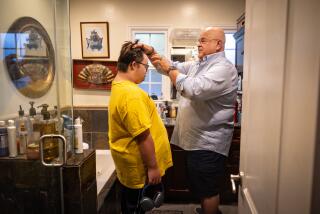SBA Says It’s Likely to Run Out of Funding by Early This Summer : Lending: Agency expects the shortfall despite its lowered ceiling on loans. Approvals rose 30% in first half of fiscal year.
- Share via
The Small Business Administration’s popular loan program, a critical source of financing for companies during Southern California’s credit crunch, has been extending loan guarantees at such a sizzling pace that it is expected to run out of money, most likely by early summer.
SBA loan approvals nationwide surged 30% in the first half of its fiscal year, despite the agency’s effort to reduce small business lending by lowering its limit per loan to $500,000.
The result is that the agency used up about 60% of its budget through the October-to-March period and now won’t have enough to cover the typically higher demand over the final half of its fiscal year, which ends Sept. 30.
Two years ago, the SBA loan guarantee program also ran out of money, but Congress came to the rescue with additional funding after the program shut down for five weeks. This time, though, Congress isn’t likely to bail it out.
The agency, in fact, hasn’t even requested supplemental aid from the new Republican Congress because “we don’t think we’ll likely be able to get it,” said SBA spokesman Mike Stammler in Washington.
That has bankers as well as small companies worried, especially in the Southland, where SBA offices in Los Angeles and Santa Ana handled about $700 million, or almost 9%, of the agency’s loan guarantees last year.
“I don’t know what’s going to happen; it’s very uncomfortable,” said David Scherer, senior vice president and head of SBA lending at Bank of Yorba Linda in Orange County. Like other SBA lenders, Scherer said he is encouraging businesses that want SBA-backed loans to move quickly.
SBA officials acknowledged this week that they are headed for a funding shortfall, but they would not speculate on when the program might run out of money. Some analysts said it could be as early as mid-June.
Stammler said the SBA could try to get by this fiscal year by dropping the cap on each loan even lower or by restricting or prohibiting loans for real estate acquisitions, which are generally larger deals.
The other option, which analysts see as more likely, is a change by Congress in the program to make borrowers and lenders--not the government--pick up the cost of loans that default.
Analysts say that cost, which the agency calls a subsidy, would probably be covered by higher interest rates to SBA borrowers and higher fees to bankers participating as SBA lenders. The agency currently guarantees 70% to 90% of approved business loans, which carry maximum interest rates of 2.75 percentage points above the prime rate.
Late last month, the Clinton Administration proposed the elimination of the SBA subsidy and other measures to streamline the agency. But it is unclear whether Congress will approve that proposal or if any action will come soon enough to keep the program afloat.
That uncertainty is likely to touch off a flurry of activity as businesses and SBA bankers rush to grab the cookies before the jar is empty.
A prolonged suspension of SBA lending would be a big setback, especially in Southern California, where conventional lending remains tight. Small Southland businesses and the area’s real estate industry have made the most of the federal program.
In the agency’s last fiscal year, SBA district offices in Los Angeles and Santa Ana approved business loans totaling $708 million, with the bulk of them going to businesses buying real estate. These transactions have come under fire from critics who say buying property is an inappropriate use of the program. The SBA lowered the loan ceiling this year to $500,000 from $750,000 partly to reduce the number of real estate loans.
However, the latest six-month figures suggest that the lower ceiling has not significantly slowed down these deals. SBA bankers say they are continuing to finance a large volume of property acquisitions by extending “piggyback loans” on top of the $500,000 SBA-guaranteed loans. That may prompt the SBA to restrict or deny loans for real estate purchases.
Nationwide, the SBA approved a record $4.58 billion in regular business loans in the first six months, up from $3.53 billion a year earlier. Nationally, the increase was fueled by $859 million in loans of less than $100,000 each made through a new program that reduces paperwork and spreads SBA funds over a wider group.
However, in the Los Angeles and Orange counties area, these smaller loans, which are considered more risky, accounted for less than 7% of the total volume of $292 million in SBA loans made in the first six months.
(BEGIN TEXT OF INFOBOX / INFOGRAPHIC)
Loan Landslide
Dealing with more loans than it expected during the first half of its fiscal year, the Small Business Administration used up 60% of its annual budget by March 31 and could run out of funds soon as it faces even greater demand in the next six months. Loan approvals and totals for the first half of the fiscal year; dollar amounts in millions:
1994 1995 Percent 1994 1995 loans loans increase amount amount Nationwide 14,361 27,969 95 $3,530.0 $4,580.0 Los Angeles District 382 575 51% $131.8 $174.2 Santa Ana District * 295 366 24 113.2 118.0
Percent increase Nationwide 30 Los Angeles District 32% Santa Ana District * 4
* Includes San Bernardino and Riverside counties
Source: SBA
Researched by JANICE L. JONES / Los Angeles Times
More to Read
Inside the business of entertainment
The Wide Shot brings you news, analysis and insights on everything from streaming wars to production — and what it all means for the future.
You may occasionally receive promotional content from the Los Angeles Times.










